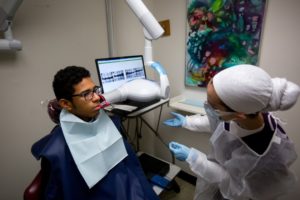Dental, vision and the big picture of integrated benefits
Integrated benefits can improve patient care and better support human resource departments. Integration can also help connect the dots between different health benefits, like dental and vision, and employers can use this information from routine exams to identify and manage larger health issues for employees.
Dental care and overall health
The most commonly diagnosed condition that shows up in the mouth is periodontal disease, which infects the tissues holding the teeth in place. Symptoms include loose teeth and swollen, receding or bleeding gums and it can lead to more serious health issues if the infection spreads through the bloodstream, especially for those with chronic health conditions like diabetes, pregnancy and coronary heart disease. By improving dental health for people with these chronic conditions, studies have shown that medical costs can be reduced up to 74% per pregnancy and 40% for conditions like vascular disease.
Dentists are also on the front lines of detecting signs of oral cancer, which include sores, growths or loose teeth.
Vision and overall health
While the eyes obviously allow people see everything around them, they also help vision providers see pictures of patients’ overall health, as more than 100 different health issues can show symptoms in the eyes.
According to the CDC, more than 100 million Americans adults are now living with diabetes or prediabetes, making it one of the most common medical conditions in the country. Symptoms of the disease include bleeding in the eye, which vision providers can spot during routine exams. Another common condition is shingles, which about 33% of Americans will experience at some point in their lives. Vision providers can be an early detector of shingles, often spotting it developing around the eyelids. Neurological conditions can also display symptoms in the eyes, since the eyes depend on the brain and the two are closely intertwined. Serious neurological conditions such as stroke or tumors can make patients’ eyes cross, which can be easy for vision providers to detect.
For example, according to an American Optometrists Association study, patients with diabetes, cardiovascular disease and hypertension who don’t use a comprehensive vision benefit respectively experience 20% , 15% and 7% higher medical costs.
Early intervention
Dentists and vision providers can’t always identify and diagnose diseases in a routine exam. But by identifying symptoms, they can set the early intervention process in motion and recommend what patients should do and who they should see to get proper care.
The earlier a provider detects symptoms of underlying medical conditions and a patient sees a specialist to diagnose those conditions, the more likely it is that a patient’s treatment will be successful.
In addition to giving patients better care and earlier intervention – in some cases, improving a patient’s outcome or helping them to better manage their condition – early detection can also reduce healthcare costs. Cancer treatment, specifically, can be two to four times less expensive, not to mention more successful, when the cancer is detected early.
Integration and a company’s bottom line
Integrated care enables better and more rapid information sharing between a patient’s universe of doctors and increases the instances of early detection and intervention.
On average, employer-sponsored healthcare benefits cost nearly $15,000 per employee per year and for a large company with 10,000 employees, that means spending $150 million per year on healthcare.
By improving patient care and increasing early detection with integrated care, companies can reduce absenteeism, which can otherwise cost them $1,685 per employee per year. For a company of 10,000 employees, that comes out to about $17 million per year.
What’s best for employees is also best for the company
Bottom lines and cost savings are obviously very important but integrated care also improves patient (employee) care. It will not only help retain employees but also make them more likely to recommend their employer to potential employees.
Healthy employees are crucial to a company’s ability to operate their business, maintain their workforce and manage healthcare costs. Our bodies are an interconnected system and integrating benefits can help providers identify early warning signs of disease across disciplines (medical, dental and vision) and collaborate with each other to improve employee health. Employers can play a much larger role in improving employee health and see noticeable dividends as a result. When evaluating benefits, employers need to ask how much value are they leaving on the table when their benefits aren’t integrated?

